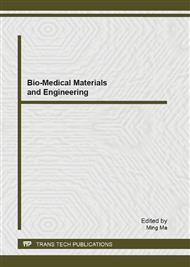[1]
Richardson SM, Hoyland JA, Mobasheri R, et al. Mesenchymal stem cells in regenerative medicine: opportunities and challenges forarticular cartilage and intervertebral disc tissue engineering. J Cell Physiol, 2010, 222(1): 23.
DOI: 10.1002/jcp.21915
Google Scholar
[2]
Vasiliadis HS, Wasiak J. Autologous chondrocyte implantation for full thickness articular cartilage defects of the knee. Cochrane Database Syst Rev, 2010 10: CD003323.
DOI: 10.1002/14651858.cd003323.pub3
Google Scholar
[3]
Matsumoto T, Okabe T, Ikawa T, et al. Articular cartilage repair with autologous bone marrow mesenchymal cells. J Cell Physiol, 2010, 225(2): 291.
DOI: 10.1002/jcp.22223
Google Scholar
[4]
Shimomura K, Ando W, Tateishi K, et al. The influence of skeletal maturity on allogenic synovial mesenchymal stem cell-based repair of cartilage in a large animal model. Biomaterials, 2010, 31(31): 8004.
DOI: 10.1016/j.biomaterials.2010.07.017
Google Scholar
[5]
Majore I, Moretti P, Stahl F, et al. Growth and Differentiation Properties of Mesenchymal Stromal Cell populations derived from Whole Human Umbilical Cord. Stem Cell Rev, 2011, 7(1): 17.
DOI: 10.1007/s12015-010-9165-y
Google Scholar
[6]
Wegener B, Schrimpf FM, Bergschmidt P, et al. Cartilage regeneration by bone marrow cells-seeded scaffolds. J Biomed Mater Res A, 2010, 95(3): 735.
DOI: 10.1002/jbm.a.32885
Google Scholar
[7]
Rotter N, Bücheler M, Haisch A, et al. Cartilage tissue engineering using resorbable scaffolds. J Tissue Eng Regen Med, 2007, 1(6): 411.
DOI: 10.1002/term.52
Google Scholar
[8]
Vinatier C, Mrugala D, Jorgensen C, et al. Cartilage engineering: a crucial combination of cells, biomaterials and biofactors. Trends Biotechnol, 2009, 27(5): 307-314.
DOI: 10.1016/j.tibtech.2009.02.005
Google Scholar
[9]
Gabay O, Sanchez C, Taboas JM. Update in cartilage bio-engineering. Joint Bone Spine, 2010, 77(4): 283.
DOI: 10.1016/j.jbspin.2010.02.029
Google Scholar
[10]
Björnsson S. Simultaneous preparation and quantitation of proteoglycans by precipitation with alcian blue. Anal Biochem, 1993, 210(2): 282.
DOI: 10.1006/abio.1993.1197
Google Scholar
[11]
Tichopad A, Dilger M, Schwarz G, et al. Standardized determination of real-time PCR efficiency from a single reaction set-up. Nucleic Acids Res, 2003, 31(22): 6688.
DOI: 10.1093/nar/gng122
Google Scholar
[12]
CHEN Lei, YANG Zhiming. Research progress of the seed cells of tissue-engineered cartilage. Chinese Journal of Reparative and Reconstructive Surgery,2003, 17(2): 143.
Google Scholar
[13]
Wang HS, Hung SC, Peng ST, et al. Mesenchymal Stem Cells in the Wharton's Jelly of the Human Umbilical Cord. Stem Cells, 2004, 22(7): 1330.
DOI: 10.1634/stemcells.2004-0013
Google Scholar
[14]
Qiao C, Xu W, Zhu W, et al. Human mesenchymal stem cells isolated from the umbilical cord. Cell Biol Int, 2008, 32(1): 8.
Google Scholar
[15]
Wulf GG, Chapuy B, Trumper L. Mesenchymal stem cells from bone marrow phenotype. Aspects of biology, and clinical perspectives. Med Klin (Munich), 2006, 101(5): 408.
Google Scholar
[16]
Wernike E, Li Z, Alini M, Grad S, et al. Effect of reduced oxygen tension and long-term mechanical stimulation on chondrocyte-polymer constructs. Cell Tissue Res, 2008, 331(2): 473.
DOI: 10.1007/s00441-007-0500-9
Google Scholar
[17]
Budde S, Jagodzinski M, Wehmeier M, et al. No effect in combining chondrogenic predifferentiation and mechanical cyclic compression on osteochondral constructs stimulated in a bioreactor. Ann Anat, 2010, 192(4): 237.
DOI: 10.1016/j.aanat.2010.04.001
Google Scholar
[18]
Furumatsu T, Shukunami C, Amemiya-Kudo M, et al. Scleraxis and E47 cooperatively regulate the Sox9-dependent transcription. Int J Biochem Cell Biol, 2010, 42(1): 148.
DOI: 10.1016/j.biocel.2009.10.003
Google Scholar
[19]
Topol L, Chen W, Song H, et al. Sox9 inhibits Wnt signaling by promoting beta-catenin phosphorylation in the nucleus. J Biol Chem, 2009, 284(5): 3323.
DOI: 10.1074/jbc.m808048200
Google Scholar
[20]
Lorda-Diez CI, Montero JA, Martinez-Cue C, et al. Transforming growth factors beta coordinate cartilage and tendon differentiation in the developing limb mesenchyme. J Biol Chem, 2009, 284(43): 29988.
DOI: 10.1074/jbc.m109.014811
Google Scholar


